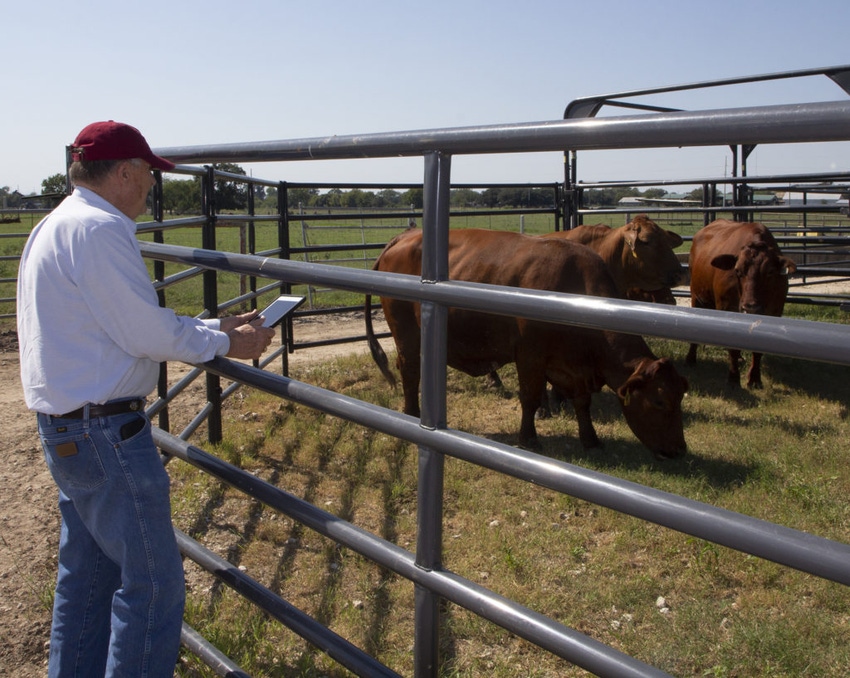Goal is to shift producer utilization of rural practitioners from reactionary approach to one of comprehensive herd health practices.
October 6, 2020

A group of Texas A&M AgriLife faculty are establishing a rural veterinarian network to provide education and assistance with a goal of making rural veterinary practices sustainable, according to an announcement from Texas A&M AgriLife.
Many rural large animal practices are operated by older veterinarians, and younger veterinary professionals are going to pet care because it’s more lucrative, said Dr. Tom Hairgrove, Texas A&M AgriLife Extension Service cattle veterinary specialist in the Texas A&M University department of animal science. That could result in the reduction of rural large animal practices.
“We know livestock enterprises are major contributors to rural communities,” Hairgrove said. “We want to improve the communication and cooperation between the livestock industry and the veterinary profession to ultimately improve livestock health and economic sustainability for rural communities.”
Three-year project
Hairgrove will lead the “Improving the Sustainability of Rural Veterinarians Through Mentoring, Targeted Education, Telemedicine & Monitoring of Disease Syndromes” project, funded by a U.S. Department of Agriculture National Institute of Food & Agriculture grant.
Texas AgriLife said the project goal is to shift producer utilization of rural practitioners from a reactionary approach to one of comprehensive herd health practices that can help prevent metabolic diseases, respiratory and reproductive diseases. By doing so, the practitioner becomes a greater asset to producers.
“Veterinarians responding in a ‘fire engine’ manner simply is no longer practical,” Hairgrove said. “We need livestock producers to realize that veterinarians can contribute more to their operation profits if a comprehensive health management program is developed.”
A first step can be utilizing the local veterinarian to focus on proper stocking rates, forage and herd management to eliminate overstocking of forage systems, he said.
“We believe if we can change producer mindset to one of ‘complete herd health’ instead of only calling the vet to periodically pull a calf, it will be good not only for the veterinarian and the economics of the rural communities but to the producer’s bottom line as well,” he said.
The project brings in the expertise of Dr. David Anderson, AgriLife Extension economist; Dr. Luis Tedeschi, Texas A&M AgriLife Research animal nutritionist; Dr. Ron Gill, AgriLife Extension livestock specialist, and Dr. Ky Pohler, assistant professor of physiology reproduction in the animal science department. Joining them are veterinarians Dr. James Thompson, professor of food animal theriogenology, and Dr. Jennifer Schleining, clinical associate professor large animal medicine and surgery in the Texas A&M College of Veterinary Medicine and Biomedical Sciences, and Dr. John Wenzel, New Mexico State University Cooperative Extension veterinarian.
“We know veterinarians can make producers money by helping them develop vaccination programs and by working with them to outline nutrition programs to improve their calving and weaning rates,” Gill said. “But if ranchers do not engage with and employ the services of rural veterinarians, the vet practice will not be sustainable, and the producers won’t realize that additional benefit.”
Developing relationships
Sitting on the Veterinarian Loan Repayment Program board for many years, Hairgrove said he knows firsthand that many early career veterinarians will spend the three years required by the loan program in a rural area and then leave, because without community support, they cannot be sustainable, and the economic and physical stress becomes too much.
Many times, these young, early career veterinarians in rural areas are practicing in isolation and have limited communication with other veterinarians, nutritionists, reproductive specialists or other groups who support food animal agriculture, AgriLife said.
Hairgrove said the project’s first step will be to establish a mentoring program with experienced veterinarians. The network of rural practitioners will help those in the underserved rural areas feel more engaged and part of a larger group experiencing similar issues in production agriculture.
AgriLife Extension will initiate monthly “virtual rounds” focusing on cases of importance. Faculty from Texas A&M’s College of Veterinary Medicine and department of animal science will participate in these rounds.
They will utilize telemedicine to share videos of cases, radiographs, laboratory data and other pertinent information required to establish meaningful diagnosis.
The value of these rural veterinary practices goes beyond just another business in the community, Hairgrove said.
Veterinarians servicing rural areas are generalists by necessity, and their practices include food and companion animals and sometimes farm-raised wildlife. These practitioners are on the front lines and will be the first to encounter emerging, re-emerging and transboundary livestock diseases.
Another of the project’s goals is to engage veterinary/vet tech students and early career veterinarians in a disease syndrome surveillance program, which has been proved viable through a pilot project, the announcement said. They will use a phone app to gather information for a central database.
This central database will be mined by Tedeschi, who will use artificial intelligence to sort through the information and provide feedback to practitioners.
In addition, they will coordinate with animal health regulatory agencies in Texas and New Mexico, such as Dr. Andy Schwartz, Texas Animal Health Commission state veterinarian, who will be able to monitor disease patterns. Also, cooperation with livestock organizations such as Texas & Southwestern Cattle Raisers Assn., Independent Cattlemen’s Association of Texas and the New Mexico Cattle Growers Assn. will be essential.
“We are excited about this, because we are tying all these entities together and everyone will benefit by being able to see disease patterns early in the process,” Hairgrove said.
He said the combination of the disease surveillance with continuing education and mentoring of early career veterinarians will enable them to provide comprehensive animal health management programs.
“This program will require collaboration among those involved in veterinary medicine, animal science, animal behavior, agriculture economics and ecosystems management,” he said. “The use of telemedicine within the context of a valid veterinarian-client-patient relationship will be essential for the efficient delivery of leading-edge veterinary services to rural communities.”
You May Also Like


.png?width=300&auto=webp&quality=80&disable=upscale)
